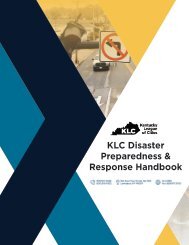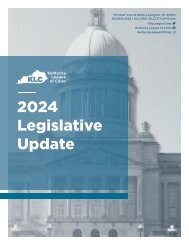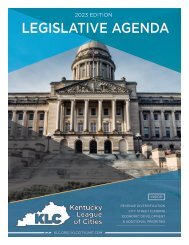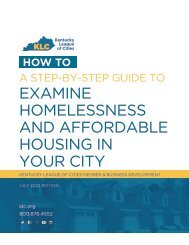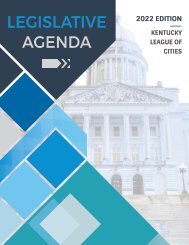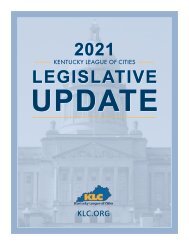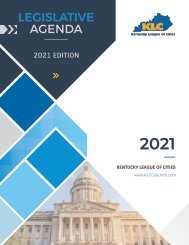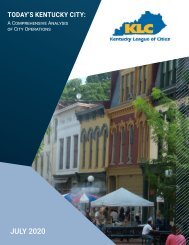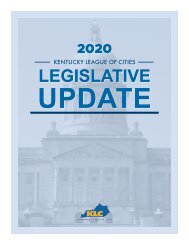City Expense Reimbursement Informational Pamphlet
Kentucky apportioned $300 million of the $1.7 billion received from the Coronavirus Relief Fund to reimburse cities and counties for COVID-related expenses. This pamphlet provides a review of the program and a link to preliminary estimates of the maximum amount cities could receive.
Kentucky apportioned $300 million of the $1.7 billion received from the Coronavirus Relief Fund to reimburse cities and counties for COVID-related expenses. This pamphlet provides a review of the program and a link to preliminary estimates of the maximum amount cities could receive.
You also want an ePaper? Increase the reach of your titles
YUMPU automatically turns print PDFs into web optimized ePapers that Google loves.
COVID-19<br />
Relief Funds<br />
Kentucky received $1.7 billion<br />
for pandemic-related expenditures<br />
through the Coronavirus Relief Fund.<br />
Governor Andy Beshear agreed to disburse<br />
$300 million of these relief funds to<br />
cities and counties with the maximum<br />
amount available for each to be based on<br />
approximate population size as recorded<br />
in the most recent census data.
Each Kentucky city and county<br />
will receive reimbursement of eligible expenses incurred<br />
by the local government between March 1, 2020, and<br />
December 30, 2020. <strong>Expense</strong>s must be unbudgeted as of<br />
March 27.<br />
U.S. Department of the Treasury<br />
guidance lists the following<br />
expenditures as covered under<br />
the fund.<br />
MEDICAL EXPENSES<br />
• Provisions of COVID-19 testing<br />
• Emergency medical response, including emergency medical<br />
transportation<br />
• Medical facilities and medicine capabilities<br />
PUBLIC HEALTH EXPENSES<br />
• Communication and enforcement of public health orders<br />
• Acquisition and distribution of personal protective equipment<br />
and sanitizing products for public health and safety workers<br />
• Disinfection of public areas or facilities<br />
• Public safety and quarantining measures<br />
• Technical assistance on mitigation of COVID-related threats<br />
PAYROLL EXPENSES<br />
• Public safety, public health, health care, human services,<br />
and similar employees whose services are substantially<br />
dedicated to mitigating or responding to the pandemic<br />
*Public safety and public health payroll expenses that are<br />
unbudgeted as of March 27 can be presumed to be COVID-related
ECONOMIC SUPPORT EXPENSES<br />
• Grants to small businesses<br />
• Payroll support program<br />
• Unemployment insurance if not otherwise reimbursed<br />
COMPLIANCE EXPENSES<br />
• Food delivery to vulnerable populations<br />
• Facilitation of distance learning, including technological<br />
improvements<br />
• Improvement of telework capabilities for public employees<br />
• Paid sick and paid family and medical leave to public employees<br />
• Maintenance of prisons and jails<br />
• Care for the homeless<br />
INELIGIBLE EXPENSES<br />
• Payroll or benefits expenses for employees whose work duties<br />
are not substantially dedicated to mitigating or responding to<br />
the COVID-19 public health emergency<br />
• Workforce bonuses other than hazard pay or overtime<br />
• <strong>Expense</strong>s that have been or will be reimbursed under any<br />
federal program, such as the reimbursement by the federal<br />
government pursuant to the CARES Act of contributions by<br />
states to state unemployment funds<br />
• Damages covered by insurance<br />
• <strong>Reimbursement</strong> to donors for donated items or services<br />
• Severance pay<br />
• Legal settlements
HOW YOUR CITY CAN APPLY<br />
Cities can complete an application with<br />
documentation of claimed expenses at the DLG<br />
website or by visiting https://bit.ly/DLGApplication.<br />
<strong>Expense</strong>s must have occurred between March 1,<br />
2020, and December 30, 2020.<br />
To access a preliminary list of maximum amounts for<br />
each Kentucky city, scan the QR code on your<br />
smartphone or visit https://bit.ly/<strong>City</strong>Projections.<br />
SCAN ME





